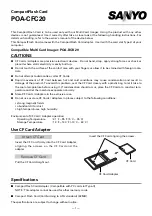Serial ATA RAID User’s Guide
Step 0. What is RAID
Know How
This section will give you an overview about the RAID system and introduce
the basic background and glossary which you need to know before using
“SiS RAID Controller Application”.
1.
RAID
: (Redundant Array of Independent Disk Drives) use jointly several
hard drives to increase data transfer rates and data security. It depends
on the number of drives present and RAID function you select to fulfill
the security or performance purposes or both.
2.
RAID 0
: Also known as “Stripping”. All of the data are distributed evenly
to all of the existing drives. You gain benefits on performance because
the data transfer rate is multiplied by the number of drives. However,
RAID 0 has high risks of data security. All of the stored data will be lost if
even any one drive in the RAID set crashes.
3.
RAID 1
: Also known as “Mirroring”. Two hard drives are required. The
goal of RAID 1 is to ensure data security. Data is written to two or more
drives synchronously. That is, 100% duplication of data from one drive
to another.
4.
JBOD
: (Just a Bunch of Drives). Also known as “Spanning”. Two or
more hard drives are required. Several hard disk types configured as a
single hard disk. The hard drives are simply hooked up in series. This
expands the capacity of your drive and results in a useable total capacity.
However, JBOD will not increase any performance or data security.
Performance hints and recommend setting
For the best performance and reliability, please read the following
suggestions.
1. Use the same model hard drives.
2.
If you have only two Serial ATA drives, the auto-configure function will
assign each on a different channel as a master drive.
3. Always use 80-conductor cables.
4. We strongly recommend you should use “DMA” transfer mode.
5. The recommended block size is “64K” when creating RAID 0.
3


















